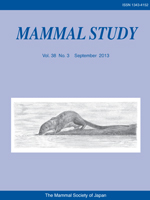Diet preferences of three captive northern fur seals for seven prey items (Okhotsk atka mackerel, rainbow trout, common mackerel, walleye pollock, Pacific sand lance, horse mackerel, and Japanese common squid) were measured through repeated two-choice tests. Preference indices estimated from the paired consumption data using the normal Bradley-Terry model revealed the existence of diet preferences and their individual variation. The three seals generally preferred Okhotsk atka mackerel, rainbow trout, and common mackerel, but showed individual differences for less preferred food items. The preferred items had moderate food size and high energy content per one item. Once diet preferences were determined, animals were given rainbow trout laced with lithium chloride (LiCl) to induce conditioned taste aversion (CTA). Four to five LiCl treatments were required for CTA, but could only induce temporary aversion of rainbow trout in favor of horse mackerel. Choice tests after CTA demonstrated a decrease in preference indices for rainbow trout in the three animals, but the ranking and preference indices of rainbow trout did not fall below those for horse mackerel. These results suggest that preference and aversion are relative phenomena, and the success of CTA is dependent on the reduction of preference relative to other food items.
How to translate text using browser tools
1 September 2013
Measurement of Diet Preference and its Variability in Captive Northern Fur Seals (Callorhinus ursinus)
Masashi Kiyota,
Hiroshi Okamura,
Hiroya Itou,
Noriyasu Suzuki,
Kaoru Kohyama
ACCESS THE FULL ARTICLE

Mammal Study
Vol. 38 • No. 3
September 2013
Vol. 38 • No. 3
September 2013
Bradley-Terry model
Choice test
conditional taste aversion
food selection
opportunistic feeder




